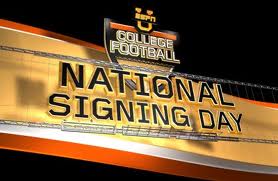Lopsided ‘Signing Day’ Unjustly Binds Players Only
Wednesday was “National Signing Day” for the country’s football-playing high school seniors. It’s a virtual national holiday in the world of sports, an occasion that’s grown to garner wall-to-wall TV coverage and up-to-the minute Web updates. The NCAA says about 7,000 football players annually sign letters-of-intent to accept scholarship offers (not to mention 4,000 basketball players and 25,000 student-athletes in non-revenue sports).
Thus concludes another recruiting cycle in which desperate football coaches logged thousands of miles and sat in numerous living rooms, hoping to land the nation’s prized recruits. Those blue-chip prospects – some courted by dozens of schools that often learn ‘The Decision’ like everyone else, by watching a press conference on ESPN – can have a dramatic impact on a coach’s career and a program’s fortunes.
But a football (or basketball) player’s signature on a scholarship has a vastly different meaning than a coach’s signature on a contract. And guess which party gets the short end of the deal.
A few weeks after then-Connecticut coach Randy Edsall sat in the home of recruit Michael Nebrich and made empty promises, we learned that Edsall was leaving UConn for the Maryland job. “I don’t want to say it made me feel betrayed, because he had to do what he had to do for his family,” Nebrich told The Washington Post last month. “Just with everything he was saying to me and assuring me he was going to be there, it was a weird feeling.”
Far from weird, it’s perfectly normal when college coaches depart for better opportunities, regardless of the time left on their contracts or the pledges made to incoming recruits. It happens every year without fail.
Among the opportunistic joining Edsall this offseason were Brady Hoke, jumping from San Diego State to Michigan; Al Golden, jettisoning Temple for Miami; and Jim Harbaugh, leaping from Stanford to the San Francisco 49ers. One school, the University of Pittsburgh, led two coaches to bolt their respective campuses early: Mike Haywood from Miami (Ohio) and Todd Graham from Tulsa, the latter signed after Haywood’s arrest for domestic violence prompted his firing.
However, a school isn’t obligated to release incoming recruits with second thoughts, or returning players who want to transfer, once the coach leaves. Schools must agree to release players, who otherwise can be forced to sit out and lose a year of eligibility. That’s the law according to the NCAA. Worse, individual schools and conferences often have their own, more-restrictive rules governing transfers.
Folks complain that student-athletes aren’t paid (as if tuition, room, board, transportation, health care, etc. are worthless?), but the real outrage is holding them hostage after coaching changes!
It’s unrealistic to suggest the coach doesn’t matter when players choose a school. The coach is a factor for blue-chippers as well as under-the-radar players, who still manage to attract multiple suitors. There’s only so much disparity between accredited institutions of higher learning, and they aren’t nearly as different as pro-style and spread offenses.
If the NCAA really cared about players more than profits, coaches wouldn’t be alone in their freedom to roam. Some players would stick with their letter-of-intent, regardless of a new coach. But they should have the opportunity to re-evaluate their decisions and act accordingly. Just like each school has the annual opportunity to re-evaluate its scholarship decisions and either renew them or revoke them.
Yes, allowing student-athletes to easily change their minds could lead to chaos, but that would be the NCAA’s problem. If a large number of Edsall’s players and recruits followed him, Connecticut’s program would be a shambles and some returning Maryland players might be out of a scholarship. Free agency in college sports might make Major League Baseball blush. But everything could be sorted out eventually with an adequate period of time for sanctioned movement.
As it is, I wonder how some coaches keep a straight face while wooing the thousands of recruits who sign each year. I seriously doubt that Golden told his Temple recruits he’d be around only as long as it took land a big-time job. Not that I blame him for jumping to “The U,” a dream gig for most any college coach.
With so much money at stake nowadays, coaches break contracts faster than teams break huddles. Great. That’s the American way, looking out for No. 1, capitalizing on opportunity and so forth.
But without a similar option to break their “contracts” (their letters-of-intent), players are virtually indentured servants, needing permission to leave without penalty, yet subject to being dropped each year at the school’s discretion.
That’s something Wednesday’s beaming recruits should think about.
And it’s something the NCAA should work on changing.
 Follow
Follow

